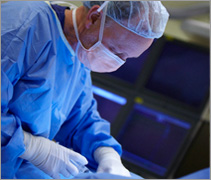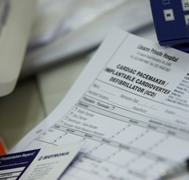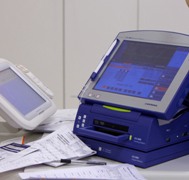
A pacemaker has a pulse generator (battery or box) that sits under the skin below your collarbone, and 1-3 pacing leads that are inserted through the arm veins into the heart. The choice of pacemaker type depends on your symptoms and underlying heart disease. Most pacemakers have one or two leads, placed in the top and bottom chambers of the heart. Occasionally a third lead is placed over the left side of the heart , to assist the treament heart failure.
The pacemaker battery lasts about 5-8 years, and will be replaced through the original incision at that time. The leads remain in position lifelong.
Risks

There is a risk of infection, so you will be given antibiotics in the drip prior to the procedure. If you are having the pacemaker battery replaced, you will also take antibiotic medication when you go home.
Uncommon complications include:
- Lead dislodgement, that may require repositioning with another procedure
- Collapsed lung or pneumothorax requiring insertion of a tube to reinflate
- Perforation of the heart by the lead causing cardiac tamponade (which rarely can be fatal), requiring drainage with a tube into the chest
- Blood clot formation in the arm veins, where the pacing leads are inserted, causing arm swelling or discomfort
- Rarely, heart attack, stroke, death or allergic reaction to the medication.
Whilst we endeavour to minimise these risks, should a complication occur, there is emergency equipment available to manage them. Your cardiologist will discuss other individual risks with you prior to the procedure.
Pacemaker procedure

The incision is about 5cm, and will be covered by a waterproof dressing for one week. The procedure takes about 1 ½ hours, then you will be monitored for 4 hours or stay overnight, before being discharged home.
Instructions post procedure:
- Minimise use of your left arm for the next 24 hours. This is to reduce any bruising and pain around the wound area, and to maintain correct position of the pacemaker leads.
- Avoid lifting your left arm above shoulder height for one week, to allow time for the pacemaker leads to settle into their positions in your heart. Actions to particularly avoid include washing your hair, reaching for high shelves and hanging out the washing.
- You may shower as the dressing is waterproof.
- You may remove the dressing after seven days. The stitches are dissolvable (they do not need to be removed).
- You may experience some discomfort over the pacemaker and in your shoulder for the first few days, which is usually relieved by Panadol or Panadeine.
- You cannot drive for 2 weeks post procedure, which is a VicRoads recommendation.
Mobile phones – you may use one, but avoid carrying it in the pocket over your pacemaker.
MRI – you cannot have an MRI scan with most pacemaker types.
You will be sent a Pacemaker identification card, that you should carry with you at all times.
Once discharged from the hospital, you will have a pacemaker check in the office in 4-6 weeks, then every 6-12 months. The latest pacemakers can be monitored remotely, with a device that is attached to a phone line in your house and can transmit information regarding the function and integrity of your pacemaker back to our office (securely).
